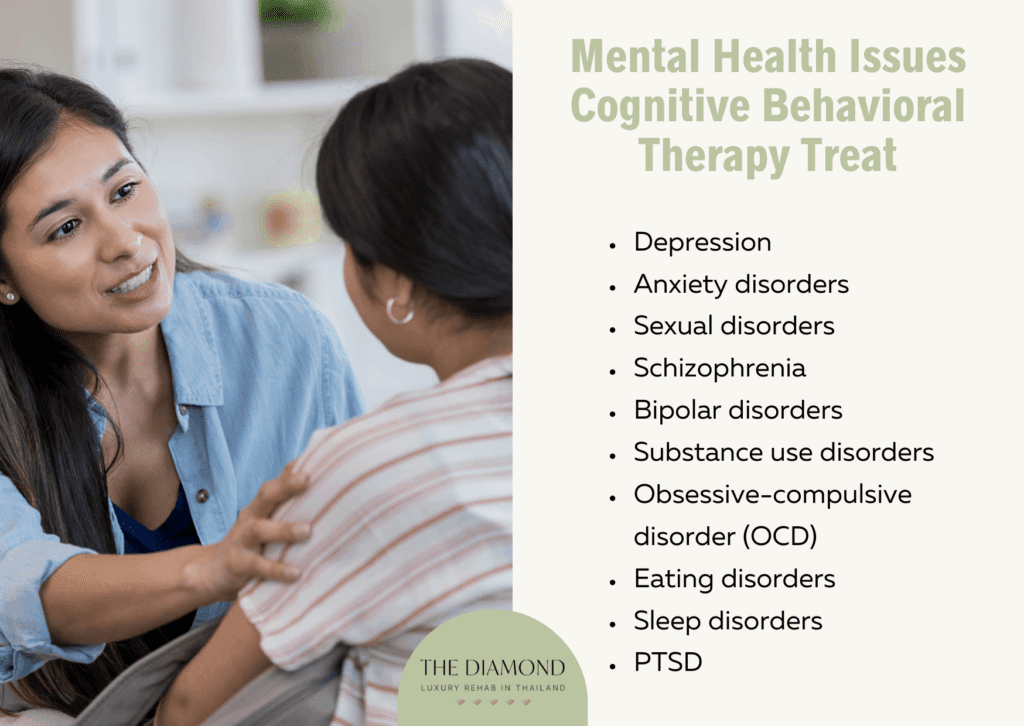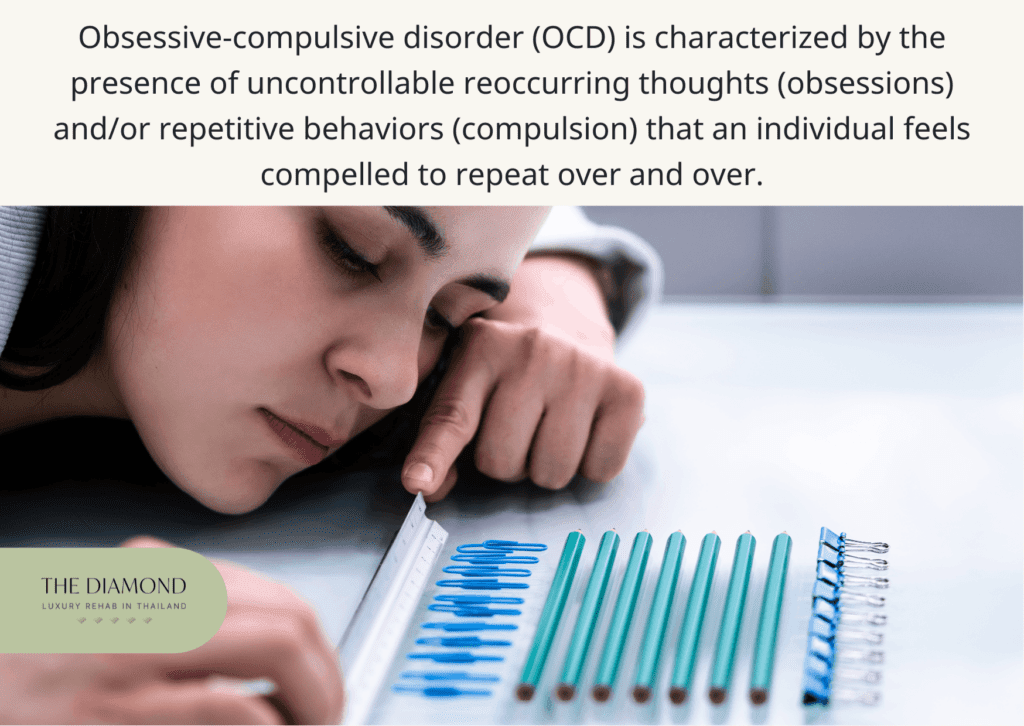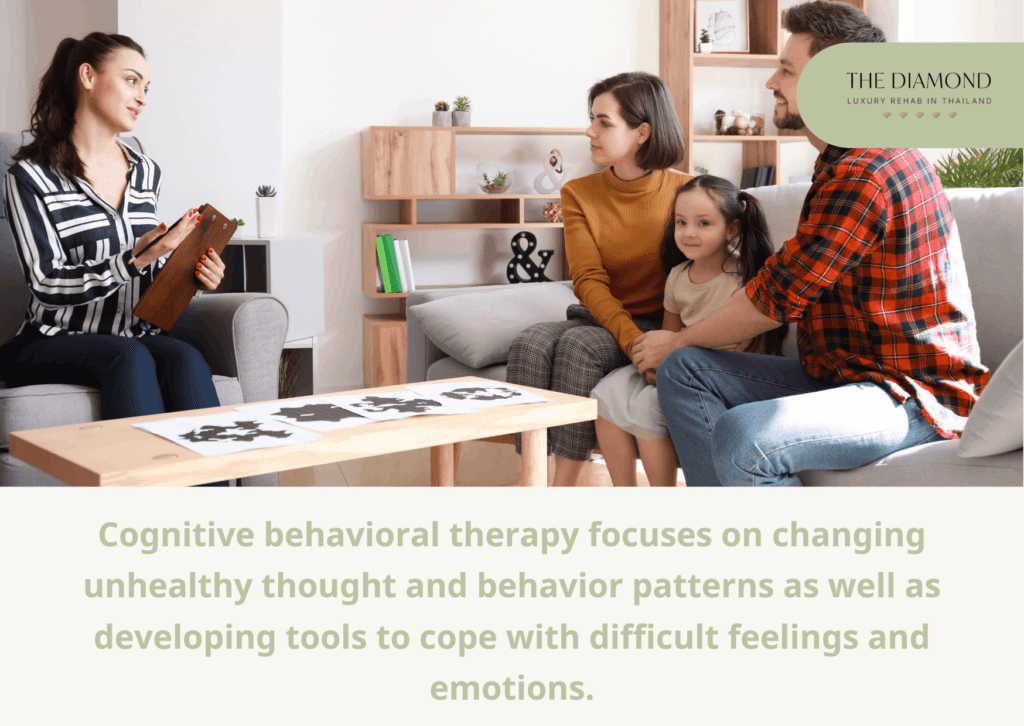Cognitive behavioral therapy (CBT): definition, purpose, and how does it work?
Table of content
- What is cognitive behavioral therapy?
- What are the main goals of cognitive behavioral therapy?
- What is the purpose of cognitive behavioral therapy?
- What mental health issues do cognitive behavioral therapy treat?
- What is the risk of cognitive behavioral therapy?
- What is the benefit of cognitive behavioral therapy?
- What can you expect in cognitive behavioral therapy?

Cognitive behavioral therapy is a form of psychological treatment that falls under the category of talk therapy, also known as psychotherapy. It is widely practiced worldwide and can be utilized either as a standalone treatment or in combination with other treatment options, such as medication.
The purpose of cognitive behavioral therapy is to help individuals identify and reshape their negative thinking and behavior patterns. Therapists aim to teach individuals how to handle everyday life situations with their mental health issues.
The therapy treatment plan is usually divided into a maximum of 20 sessions every week or every other week. In these sessions, the therapist works with the patient to identify and change negative thoughts, emotions, and behaviors.
What is cognitive behavioral therapy?
Cognitive behavioral therapy is a form of psychological treatment that focuses on identifying and reshaping problematic behaviors, thoughts, and emotions. CBT focuses on eliminating automatic negative thoughts that worsen our mental state, and it is a combination of cognitive therapy and behavioral therapy, according to Kendra Cherry in her 2022 article published on Verywell Mind.
CBT is a useful tool that is often used in combination with other treatment options to treat various mental health conditions, including depression, anxiety, and eating disorders, according to a 2019 article titled “Cognitive behavioral therapy” and published by Mayo Clinic.
How common is cognitive behavioral therapy?
Cognitive behavioral therapy is one of the most common and studied forms of therapy worldwide. According to Melissa Porrey, in her 2021 article “What Is Cognitive Behavioral Therapy?” published by Verywellhealth, 67% of social workers use CBT as their main form of treatment in therapy.
Roughly 50% of patients who attended cognitive behavioral therapy made a reliable improvement, according to Pybis et al. in their 2017 article published in the BMC Psychiatry Journal. Cognitive behavioral therapy is gaining popularity as an evidence-based practice and is quickly becoming the dominant approach among practicing psychologists, according to a 2008 article by Brandon Guadiano published in the Evidence-Based Mental Health Journal.
What are the main goals of cognitive behavioral therapy?
The main goals of cognitive behavioral therapy include modifying negative thinking and behavior patterns, developing healthy coping strategies, establishing problem-solving skills, and getting back into a healthy daily routine. According to Cleveland Clinic, CBT is a goal-oriented approach where therapists and patients collaborate to identify personalized goals. By working towards these goals, CBT aims to enhance mental health and empower individuals to deal effectively with life’s challenges.
What is the purpose of cognitive behavioral therapy?
The purpose of cognitive behavioral therapy is to help individuals identify and reshape their negative thinking and behavior patterns. CBT aims to equip individuals with various coping skills that can be used not only in therapy but also in everyday life. CBT also aims to help individuals understand that they cannot control every aspect of their life, only how they perceive it, according to Kendra Cherry, in her article “What Is Cognitive Behavioral Therapy (CBT)?” published in 2022.
How does cognitive behavioral therapy affect the body?
Cognitive behavioral therapy has secondary effects on the body, as CBT primarily focuses on improving mental well-being. Most of the physical effects are a result of the changes in one’s mental state. For instance, CBT enables an individual with an anxiety disorder to unwind and relax as their thought and behavior patterns begin to adjust.
How does cognitive behavioral therapy affect the brain?
Cognitive behavioral therapy aims to modify the brain’s thought and behavioral patterns. According to Brett Friedman in a 2019 article published by FHE Health, cognitive behavioral therapy essentially guides the brain in adopting alternative reaction processes, whether related to thoughts or behaviors. By doing so, it gradually reshapes the brain and alters the neural pathways involved.
What mental health issues do cognitive behavioral therapy treat?

The mental health conditions that cognitive behavioral therapy treats are listed below:
- Depression
- Anxiety disorders
- Sexual disorders
- Schizophrenia
- Bipolar disorders
- Substance use disorders
- Obsessive-compulsive disorder (OCD)
- Eating disorders
- Sleep disorders
- PTSD
1. Depression
Depression, also known as major depressive disorder, is a common mood disorder that negatively affects how one thinks, feels, and acts, according to the National Institute of Mental Health. This mental health condition can significantly affect an individual’s daily life, manifesting through symptoms such as persistent sadness, loss of interest in previously enjoyed activities, and disturbances in sleep patterns.
Cognitive behavioral therapy teaches individuals with depression to be aware of their negative thinking patterns and also provides them with the tools to adjust these patterns, according to a 2021 article titled “Cognitive Behavioral Therapy for Depression” and published by Healthline. These tools could include promoting mindfulness, self-questioning, and self-compassion.
2. Anxiety disorders
Anxiety disorders are the most common mental health disorders, according to the American Psychiatric Association, and involve a feeling of excessive fear or anxiety. It is characterized by the anticipation of future worries and is often accompanied by muscle tension and avoidance tendencies.
According to Hailey Shafir in her 2022 article posted on Choosing Therapy, cognitive behavioral therapy helps individuals with anxiety identify and evaluate the consequences of their problematic behavior patterns. These patterns include avoidance, control, distraction, and procrastination. CBT also teaches individuals with anxiety disorders how to replace these patterns with other, more helpful patterns.
3. Sexual disorders
Sexual disorders refer to any type of dysfunction that prevents an individual from experiencing satisfaction from sexual activities, according to Cleveland Clinic. A sexual disorder could have numerous psychological or physical causes, and it could occur in people of all ages.
A large part of cognitive behavioral therapy is psychoeducation, which refers to providing the patient with information about their sexual disorder to help them reassess how they assess their thoughts and emotions. This part of CBT is vital when treating sexual disorders since sex and information about sex is often taboo and not talked about in society.
4. Schizophrenia
Schizophrenia is a severe mental health condition characterized by abnormal interpretations of reality. According to Mayo Clinic, symptoms of schizophrenia may manifest as visual or auditory hallucinations, delusions, or disordered thinking. There is no cure for schizophrenia, and people who suffer from this mental health condition require lifelong treatment.
Cognitive behavioral therapy teaches people with schizophrenia how to test the reality of their thoughts and perceptions as well as how they can manage symptoms. According to an article titled “Cognitive Behavioral Therapy for Schizophrenia,” published by NYU Langone Health, CBT can reduce the severity of symptoms and lower the risk of relapse for individuals with schizophrenia.
5. Bipolar disorders
Bipolar disorder is a mental health disorder that causes abrupt and unusual shifts in an individual’s mood and energy, according to the National Institute of Mental Health. Bipolar disorders are lifelong conditions, but the symptoms can be managed through medication and psychotherapy.
Cognitive behavioral therapy is a common type of psychotherapy as it helps individuals to address feelings of guilt or other negative thoughts after a manic episode. In his 2021 article “Cognitive Behavioral Therapy for Bipolar Disorder,” published by Healthline, Anthony Watt states that bipolar disorder can result in depressive episodes and feelings of hopelessness. CBT helps patients with bipolar to recognize common indicators of a manic/depressive episode and plan accordingly.
6. Substance use disorders
Substance use disorder (SUD) is a mental health disorder that leads to the inability to control the use of legal or illegal substances, despite being aware of harmful consequences, according to Mayo Clinic. Drugs, alcohol, and medications are typical substances that individuals with SUD struggle with.
Cognitive behavioral therapy can help individuals struggling with substance use disorder as it involves the process of documenting and examining thoughts, emotions, and situations that trigger substance use. Thereafter, skills and coping mechanisms are taught to avoid these triggers and ultimately change the individual’s thought patterns.
7. Obsessive-compulsive disorder (OCD)

Obsessive-compulsive disorder (OCD) is characterized by the presence of uncontrollable reoccurring thoughts (obsessions) and/or repetitive behaviors (compulsion) that an individual feels compelled to repeat over and over. According to the American Psychiatric Association, OCD can severely interfere with a person’s work, social, and school life.
Cognitive behavioral therapy can assist individuals with OCD in identifying and breaking the association between feelings of distress and the triggers, such as objects, situations, or thoughts that evoke this distress. In “Understanding CBT for OCD,” an article published by Penn Psychiatry, it is explained that cognitive behavioral therapy also aims to break the association between engaging in ritualistic behavior and reducing feelings of distress.
8. Eating disorders
Eating disorders are behavioral conditions that are characterized by a severe and persistent disturbance in eating behaviors as well as distressing thoughts and feelings regarding food, weight, and shape. Some of the most prevalent eating disorders include anorexia nervosa and bulimia nervosa.
Cognitive behavioral therapy for eating disorders challenges core beliefs and patients’ self-destructive patterns. It replaces unhelpful thinking, like the extreme “all or nothing” mindset, with healthier, long-term perspectives. According to “Cognitive behavioral therapy (CBT) for eating disorders,” a 2022 article posted on Within Health, the aim of CBT for eating disorders is to break down the central belief and processes that sustain the disorder and promote nuanced thinking.
9. Sleep disorders
Sleep disorders refer to conditions that affect the quality and amount of sleep a person gets, according to Cleveland Clinic. Sleep disorders could have an effect on someone’s mental and physical health. Some of the most common sleep disorders include insomnia, narcolepsy, and sleep apnea.
Cognitive Behavioral Therapy helps to identify the thoughts and behaviors that contribute to sleep difficulties or exacerbate them. Through CBT, a person acquires the skills to replace these thoughts and behaviors with healthy habits that promote restful sleep. According to Mayo Clinic, unlike sleep medication, CBT addresses the root causes of sleep problems rather than solely addressing the symptoms.
10. PTSD
Post-traumatic stress disorder (PTSD) is a psychiatric disorder that can appear when a person witnesses or experiences a particularly traumatic event, series of events, or set of circumstances. Events that could cause PTSD include sexual assault, serious accidents, natural disasters, war, etc.
Cognitive Behavioral Therapy assists people with PTSD in recognizing and reassessing their assumptions and thought patterns related to their trauma. By becoming aware of their thought patterns and panic reactions in everyday situations, patients can begin to uncover the underlying causes of their stress. The goal of CBT is to reshape their understanding of the traumatic event and its aftermath.
What is the risk of cognitive behavioral therapy?
The risks of cognitive behavioral therapy are listed below:
- Emotional discomfort: Cognitive behavioral therapy forces a person to feel acknowledged and explore thoughts and feelings that they might find uncomfortable to explore. Crying or feeling angry could occur during a challenging therapy session.
- Unsuitable for certain individuals: Due to the intricacies of the brain, CBT might not be beneficial for patients with complex mental health conditions or learning disabilities.
- Does not address the wider problem: CBT’s primary focus is on the individual patient’s thoughts, feelings, and actions. However, it does not address the broader issues that exist within the patient’s family or wider community, even if these factors have a significant impact on the patient’s mental well-being.
What is the benefit of cognitive behavioral therapy?
The benefits of cognitive behavioral therapy are listed below:
- Adaptive skills: Coping skills and strategies taught in cognitive behavioral therapy can be applied in everyday life during and even after they have finished their therapy course.
- Short-term treatment: Cognitive behavioral therapy is an effective short-term treatment as most courses only run 5 to 20 sessions.
- Flexible options: Cognitive behavioral therapy can be conducted individually or in group sessions as well as in person or online. This adaptability ensures that this treatment is accessible in different circumstances.
What can you expect in cognitive behavioral therapy?

When starting cognitive behavioral therapy, the main emphasis will be on exploring and addressing the person’s emotions and thoughts related to the specific issues that brought them to therapy. They can expect to be asked many questions about their thoughts, family, school, work, etc. Sometimes the questions asked by a therapist may seem intrusive, but these answers are needed in order to formulate an effective cognitive behavioral therapy plan and set goals. CBT typically centers around addressing issues with a goal-oriented approach.
According to Mayo Clinic, during the course of therapy, the therapist may assign the patient homework, which could include engaging in activities, reading materials, or practicing techniques that reinforce the lessons learned in the therapy sessions. Additionally, CBT will encourage the patient to apply the knowledge and skills they acquire during therapy to their everyday life.
How does cognitive behavioral therapy work?
Cognitive behavioral therapy is a goal-oriented treatment. The first step for a patient is to identify an issue they are facing and set a therapy goal. Once the goal is set, the therapist helps the patient identify their thoughts, emotions, and behaviors related to the issue.
Next, the therapist assists the patient in examining whether these thoughts, emotions, and behaviors are true and helpful or if they are false and unhelpful. False or unhelpful thoughts and beliefs are called cognitive distortions. These thought patterns may have been useful in the past but no longer serve a purpose.
Finally, after identifying helpful or unhelpful thoughts, emotions, and behaviors, the therapist guides the patient in reshaping them. This is the primary objective of cognitive behavioral therapy.
What happens in the first session of cognitive behavioral therapy?
The first session of cognitive behavioral therapy will typically be introductory. The therapist asks questions about the patient’s life, background, and reason for starting therapy. According to the 2022 article, “How it works – Cognitive behavioural therapy (CBT),” published by the NHS, the goal of the first session is usually to determine whether CBT will be an effective treatment for the patient.
How often will I attend therapy sessions?
Cognitive behavioral therapy sessions occur on a weekly or fortnightly (every two weeks) basis. Each session can last between 30 and 60 minutes, depending on what the therapist has planned. In certain cases, the sessions might exceed 60 minutes. According to the NHS, cognitive behavioral therapy treatment typically consists of 6 to 20 sessions.
What is the difference between cognitive behavioral therapy and psychotherapy?

Cognitive behavioral therapy focuses on changing unhealthy thought and behavior patterns as well as developing tools to cope with difficult feelings and emotions. CBT typically does not extensively delve into a patient’s past and is often utilized as a short-term treatment option for mental health conditions, according to Riley Hurst Brubaker in her article titled “Psychotherapy vs. CBT: What’s the Difference?”
Psychotherapy, on the other hand, works to reduce negative behavior patterns by allowing a client to process and heal psychological or emotional wounds that they may not have realized were there. Psychotherapy focuses on examining an individual’s past experiences and how those experiences may have influenced their current state of being.
Cognitive behavioral therapy is a form of psychotherapy, thus, the two have a similar purpose – to change thought and behavior patterns. Before choosing one over the other, it’s best to have a discussion with a medical professional to understand what treatment plan would be suited for a specific disorder/condition.

